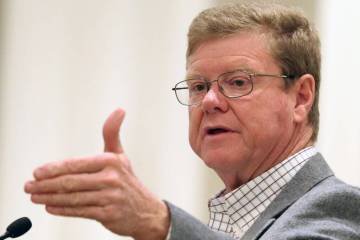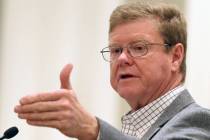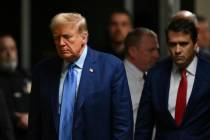In speech, Trump lays out strategy for war in Afghanistan
WASHINGTON — President Donald Trump announced his much-awaited policy on the 16-year war in Afghanistan — the longest war in U.S. history — in a speech to his favorite audience, American troops at Fort Myer, Virginia.
Trump delivered a predictable outcome — not a complete troop withdrawal, but a renewed commitment — but with a novel set of measures. Trump would not give a number for how many new troops his administration would send to Afghanistan, although reports suggest as many as 5,000 new troops could be added to the 8,400 serving there.
Also, Trump pointedly refused to offer a timeline. And the philosophy would be different — Trump promised Americans his strategy of “principled realism” will not try to recreate Afghanistan in America’s image.
“We are not nation building again,” Trump proclaimed. “We are killing terrorists.”
House Minority Leader Nancy Pelosi, D-Calif., countered, “When President Trump says there will be no ceiling on the number of troops and no timeline for withdrawal, he is declaring an open-ended commitment of American lives with no accountability to the American people.”
Trump began the address with a nod to the rancor left over after Charlottesville, Virginia — and an acknowledgment that returning troops deserve a country “that has renewed the sacred bonds of love and loyalty that united us together as one.”
Trump then moved to the subject of his speech and revealed which of his competing instincts would inform U.S. military policy. First, the president displayed the “America First” Trump who railed against U.S. tax money being diverted “to rebuild countries in our own image instead of pursuing our security interests above all other considerations.”
Then, there was the Trump who listens to his gut. He was followed by a new Trump, who showed that the Oval Office indeed had changed him.
“My original instinct was to pull out,” Trump said of his previous calls to get out of Afghanistan, “and historically I like following my instincts. But all my life, I have heard that decisions are much different when you sit behind the desk in the Oval Office.”
Over the years, Trump has made a number of statements about the war. “It is time to get out of Afghanistan,” Trump tweeted in 2012. “We are building roads and schools for people who hate us.” In 2013, he railed at the waste of “blood and treasure” — for which the Afghan government “has zero appreciation. Let’s get out.” At the time, opponents to U.S. involvement in the war looked at Trump as a kindred spirit.
But as a candidate in 2015, Trump told CNN, “I’ve never said we made a mistake going into Afghanistan.” He also said he believes the government should keep a military presence in Afghanistan of about 5,000 U.S. troops, which put him in the pro-military camp.
After his election, Trump chose top staff from the noninterventionist side — most notably Steven Bannon, chief strategist until last Friday — and military camp. Defense Secretary James Mattis and later national security adviser H.R. McMaster were involved in the Afghan war.
In June, Trump gave Mattis the authority to send several thousand extra troops, but Mattis held back as Trump mulled over competing strategies — more troops, more contractors or getting out.
No side was arguing that the strategy left over from the Obama administration was worth keeping. In 2008, President Barack Obama campaigned for office with the promise that he would reduce troop levels in Iraq but increase U.S. troop levels in Afghanistan. Obama more than doubled their number so that, by May 2010, more than 100,000 Americans were fighting in Operation Enduring Freedom. When Obama left office, 8,400 U.S. troops were serving under Operation Resolute Support, the name given to the 2014 mission to train, advise and support Afghan troops.
But the example set in Iraq stuck with Trump. Without naming Obama, Trump recalled the “hasty withdrawal” from Iraq.
“As a result, our hard-won gains slipped back into the hands of terrorist enemies,” Trump said. “Our soldiers watched as cities they had fought for and bled to liberate and won were occupied by a terrorist group called ISIS. The vacuum we created by leaving too soon gave safe haven for ISIS to spread, to grow, recruit and launch attacks. We cannot repeat in Afghanistan the mistake our leaders made in Iraq.”
“Whatever we do, we have to quit doing what we did for the last eight years,” said James Carafano, a senior fellow at the Heritage Foundation, who was a member of the Trump transition team. “That is, doing whatever we can do without looking like we’re losing.”
Only by committing to stay in Afghanistan for four years, eight years or as long as it takes can Trump expect a troop increase to pay off, Carafano argued. In rejecting “arbitrary timetables,” Trump moved in that direction.
“There’s nothing he can do or say that will surprise me or please me right now,” said Ellen Tauscher, a former California congresswoman and Obama State Department undersecretary. “I don’t believe that he actually knows what he’s doing.”
“I’m hopeful that the Administration’s announcement marks the beginning of the end of a long conflict in the region. As we move forward, it’s important that we continue to listen to our military leaders on the ground and respect that they know how to best keep America safe,” Sen. Dean Heller, R-Nev., said in a statement.
Contact Debra J. Saunders at dsaunders@reviewjournal.com or 202-662-7391. Follow @DebraJSaunders on Twitter.
























